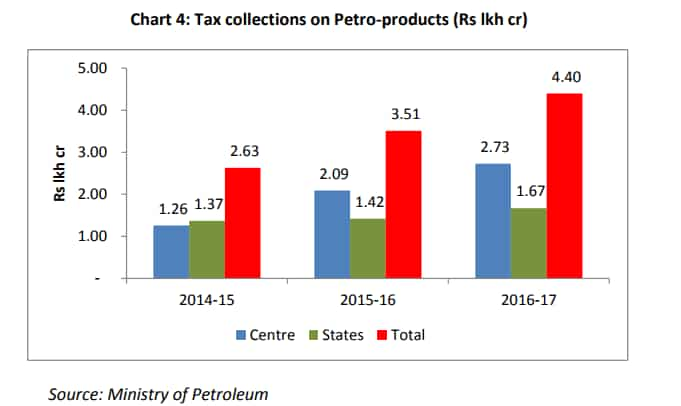Uptrend in crude oil price may further impact India's fiscal position
Given the negative balance on Petro account, CARE stated that higher prices of crude oil will increase the trade deficit and put pressure on the rupee.

Global crude oil prices reach over three-year high as the brent crude and US West Texas Intermediate (WTI) on Wednesday took a massive jump. The uptrend is likely to have a major impact on India's fiscal position.
Care Ratings, which earlier explained how does higher crude prices effect India, stated that the government is impacted by crude oil prices in two ways.
Firstly, the government earns substantial revenue from petro-products through taxation, as they have been kept out of the Goods and Services Tax (GST) regime. States are also able to levy variable taxes as a result of which prices vary across states.
Secondly, the government also provides a subsidy for fuel products in order to buffer against prices.
During last fiscal (FY17), about Rs 4.4 lakh crore was generated by government via several taxes and levies with the Centre accounting for 62% of the total.

Also in FY17, the Centre's 89% of total came from excise duties and the balance from crude oil cess and customs. Union excise collection on oil products stood at Rs 2.42 lakh crore out of the total Rs 3.87 lakh crore collections under the heading of the Central government.
Care said, “Quite clearly this group of products is very important for the government for raising revenue. Presently it appears that the government would rather not lower the tax rates as it would impact revenue collections.”
Effort has been made to lower this number by restricting the products that are to be subsidized as well as target them more effectively, Care added.
Government has set budgeted target of petroleum subsidy to Rs 25,000 crore in FY18, from Rs 27,532 crore in FY17, and Rs 29,999 crore from FY16.

If we look at the performance of petroleum products. Total imports of this indicator stood at $87 billion in FY17 out of a total bill of $383 billion, which is 23%. This is lower from a high of 37% in FY14, when imports of crude oil were $164 billion in a total of $449 billion.
India has also been a large exporter of refinery products. Exports of petro products in FY17 were $ 31.6 billion in a total of $ 276 billion, which is a share of just 11%. It has contracted compared to a share of 20% in FY14 when exports of petro products were $63.3 billion.
Given the negative balance on petro account, CARE stated that higher prices of crude oil will increase the trade deficit and put pressure on the rupee.
India`s trade deficit has already widened to nearly three-year high in October 2017 to $14.02 billion last month from $8.98 billion in September. This was because export growth contracted for the first time after more than a year.
Crude oil and its products also have a weight of 10.4% in the WPI. Any increase in the price of crude oil would impact the WPI inflation number commensurately.
According to CARE, with the state duties/taxes being ad-valorem, the final impact would be higher than the change in crude oil prices. Intuitively, 10% increase in crude oil prices would lead to around 0.5% increase in the WPI.
Analysts at Edelweiss Financial Services said, “Rising inflation leaves little room for fiscal push. Hence, spending will need to be prioritised, especially with fading tailwinds from oil.”
It may be noted that US WTI today touched a day's high of $63.56 per barrel and the Brent crude futures were trading higher than $69 per barrel.

US crude prices have been inching up since June 2017, and in first week of January 2018, they reached to the level where they stood on December 2014.
There was 32% rise recorded in Brent crude in second half of FY17, which took it already two-year higher around $65 per barrel.

A Reuters report stated that price extended gains in post-settlement trade after industry group the American Petroleum Institute said crude inventories fell by 11.2 million barrels in the week to January 5 to 416.6 million, compared with analysts’ expectations for a decrease of 3.9 million barrels.
Last month has rather been eventful for crude oil markets from a supply perspective, according to Antique Stock Broking, for a list of reasons.
Firstly, the OPEC-members decided to extend the production cut on November 2017, along with firm compliance levels, secondly, the North Sea forties and Libyan pipeline later in December 2017, developed snags, disrupting supplies.
While markets were still dealing with above disruption the Libyan pipeline carrying El Sider crude, suffered an explosion resulting in a 12% drop in crude Libya supply, Antique added.
The higher performance of crude is further expected in 2018.
Vikash Kumar Jain, analysts at CLSA, said, "We see strong crude prices throughout 2018 as Saudi Arabia aims to keep prices robust ahead of Saudi Aramco’s pending mega IPO and continued Opec discipline that offsets the effect from increased supplies from the USA."
04:38 PM IST






 Covid-depressed oil market to save India billions in import bill
Covid-depressed oil market to save India billions in import bill Oil prices hover near three-month highs on trade deal progress; set for 3rd weekly rise
Oil prices hover near three-month highs on trade deal progress; set for 3rd weekly rise Oil prices rise 2% after reports of Iranian tanker attack
Oil prices rise 2% after reports of Iranian tanker attack Crude oil prices slip, but supported by hopes US-China trade tensions could ease
Crude oil prices slip, but supported by hopes US-China trade tensions could ease Oil prices gain on US inventory drop, Middle East tensions
Oil prices gain on US inventory drop, Middle East tensions